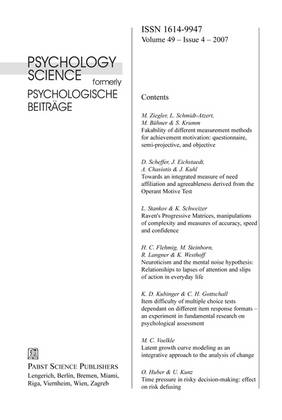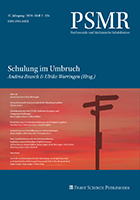Contents, Volume 49, 2007, Issue 4
MATTHIAS ZIEGLER, LOTHAR SCHMIDT-ATZERT, MARKUS BÜHNER & STEFAN KRUMM
Fakability of different measurement methods for achievement motivation: questionnaire, semi-projective, and objective
Abstract | ![]() PDF of the full article
PDF of the full article
DAVID SCHEFFER, JAN EICHSTAEDT, ATHANASIOS CHASIOTIS & JULIUS KUHL
Towards an integrated measure of need affiliation and agreeableness derived from the Operant Motive Test
Abstract | ![]() PDF of the full article
PDF of the full article
LAZAR STANKOV & KARL SCHWEIZER
Ravens Progressive Matrices, manipulations of complexity and measures of accuracy, speed and confidence
Abstract | ![]() PDF of the full article
PDF of the full article
HAGEN C. FLEHMIG, MICHAEL STEINBORN, ROBERT LANGNER & KARL WESTHOFF
Neuroticism and the mental noise hypothesis: Relationships to lapses of attention and slips of action in everyday life
Abstract | ![]() PDF of the full article
PDF of the full article
KLAUS D. KUBINGER & CHRISTIAN H. GOTTSCHALL
Item difficulty of multiple choice tests dependant on different item response formats - An experiment in fundamental research on psychological assessment
Abstract | ![]() PDF of the full article
PDF of the full article
MANUEL C. VOELKLE
Latent growth curve modeling as an integrative approach to the analysis of change
Abstract | ![]() PDF of the full article
PDF of the full article
OSWALD HUBER & URS KUNZ
Time pressure in risky decision-making: effect on risk defusing
Abstract | ![]() PDF of the full article
PDF of the full article
Fakability of different measurement methods for achievement motivation: questionnaire, semi-projective, and objective
MATTHIAS ZIEGLER, LOTHAR SCHMIDT-ATZERT, MARKUS BÜHNER & STEFAN KRUMM
Abstract
Different means can be applied to assess noncognitive personality aspects: projective, semi-projective, self-report, and objective. However, so far little attention has been paid towards the different fakability of these methods. The present study investigated this question with different achievement motivation instruments. The instruments were randomly administered to three student groups: fake bad (n = 41), fake good (n = 37), and control group (n = 41). The faking groups were given specific faking instructions while the control group only received the standard instructions. All instruments were applied computer-assisted. The results show that all tests are fakeable with the exception of the objective measure which could not be faked good as was expected. The effect sizes (d) ranged from .10 to 2.36. Cut-off scores for the detection of faking were computed based on sensitivity as well as specificity. Moreover, they were tested within a second student sample (n = 123). Sensitivity and specificity values are reported. The practical implications for test authors and practitioners are discussed.
Key words: self-rating, objective test, semiprojective test, achievement motivation, faking
Matthias Ziegler, MD
Ludwig-Maximilians-University Munich
Leopoldstrasse 13
80802 Munich, Germany
E-mail: ziegler@psy.uni-muenchen.de
Phone: ++49 (0) 89-21 80 6066
Fax: ++49 (0) 89-21 80 3000
Towards an integrated measure of need affiliation and agreeableness derived from the Operant Motive Test
DAVID SCHEFFER, JAN EICHSTAEDT, ATHANASIOS CHASIOTIS & JULIUS KUHL
Abstract
The Operant Motive Test (OMT) has been conceptionalized to measure the amalgam of aroused needs and motive-relevant traits which specifies an implementation strategy of the motive. Therefore the OMT differs conceptionally from the TAT. In Study 1 we found empirical evidence for this interaction hypothesis. The OMT, but not the TAT, was a function of a significant interaction effect of an aroused affiliation need and agreeableness. The overall correlation between OMT and TAT was small and only marginally significant in an experimental arousal condition. Study 1 also yielded evidence that the OMT measure of affiliation (i.e. m affiliation) has construct validity. Study 2 gave indirect evidence for stability of OMT m affiliation. In Study 3 the OMT predicted peer ratings of customer service orientation.
Key words: implicit motives, motive measurement, operant behavior, assessment methods
David Scheffer
Helmut-Schmidt-University
Holstenhofweg 85
22039 Hamburg, Germany
E-Mail: david.scheffer@hsu-hamburg.de
Ravens Progressive Matrices, manipulations of complexity and measures of accuracy, speed and confidence
LAZAR STANKOV & KARL SCHWEIZER
Abstract
This paper examines the effects of complexity-enhancing manipulations of two cognitive tasks - Swaps and Triplet Numbers tests (Stankov, 2000) - on their relationship with Ravens Progressive Matrices test representing aspects of fluid intelligence. The complexity manipulations involved four treatment levels, each requiring an increasing number of components and relationships among these components. The accuracy, speed of processing, and confidence measures were decomposed into experimental and non-experimental parts and represented by the latent variables within a structural equation model. In the fitted model, four latent predictor variables had substantial path coefficients to Ravens Progressive Matrices test. Experimental accuracy scores for both Swaps and Triplet Numbers tests have significant predictive validity. Thus, complexity-enhancing manipulations affect correlations fluid intelligence captured by the Ravens test. In addition, two non-experimental latent variables (speed from Triplet Numbers and confidence from Swaps) have significant path coefficients.
Key words: intelligence, ability, complexity, Fixed-links Model
Karl Schweizer
Institute of Psychology
Johann Wolfgang Goethe University
Senckenberganlage 31
60325 Frankfurt a. M., Germany
Tel.: ++49 (0) 69-798 233 50
Fax.: ++49 (0) 69-798 238 47
E-Mail: K.Schweizer@psych.uni-frankfurt.de
Neuroticism and the mental noise hypothesis: Relationships to lapses of attention and slips of action in everyday life
HAGEN C. FLEHMIG, MICHAEL STEINBORN, ROBERT LANGNER & KARL WESTHOFF
Abstract
We investigated the relationship between neuroticism and cognitive failure liability in everyday-life situations. Previous research (e.g., Robinson & Tamir, 2005; Robinson, Wilkowski & Meier, 2006) reported a positive association between the trait of neuroticism (N) and fluctuations in mental efficiency when performing elementary cognitive operations. High-N individuals were proposed to be characterized by increased noise within information processing from perception to action. To further examine this relationship, we collected self-report data from 222 individuals, measuring N via the Eysenck Personality Questionnaire and the related construct of Behavioural Inhibition System sensitivity via the BIS/BAS scales, and assessing cognitive failure liability via the Cognitive Failures Questionnaire (CFQ). The results revealed positive correlations between N and general cognitive failure liability, providing further support for the mental noise hypothesis. A more detailed investigation of CFQ subscales (Meiran et al., 1994) yielded a specific pattern, with the strongest correlation between N and the CFQ-Unintended Activation subscale (r = .40; p < .01). This suggests that high-N individuals preferably commit cognitive failures due to intrusions of task-irrelevant cognitions from associative memory.
Key words: neuroticism; mental noise; cognitive failure liability; attention
Hagen C. Flehmig
Institut für Psychologie II
Technische Universität Dresden
01062 Dresden, Germany
Phone: ++49 (0) 351-463 340 04
E-Mail: hagen.flehmig@tu-dresden.de
Item difficulty of multiple choice tests dependant on different item response formats - An experiment in fundamental research on psychological assessment
KLAUS D. KUBINGER & CHRISTIAN H. GOTTSCHALL
Abstract
Multiple choice response formats are problematical as an item is often scored as solved simply because the test-taker is a lucky guesser. Instead of applying pertinent IRT models which take guessing effects into account, a pragmatic approach of re-conceptualizing multiple choice response formats to reduce the chance of lucky guessing is considered. This paper compares the free response format with two different multiple choice formats. A common multiple choice format with a single correct response option and five distractors ("1 of 6) is used, as well as a multiple choice format with five response options, of which any number of the five is correct and the item is only scored as mastered if all the correct response options and none of the wrong ones are marked ("x of 5). An experiment was designed, using pairs of items with exactly the same content but different response formats. 173 test-takers were randomly assigned to two test booklets of 150 items altogether. Rasch model analyses adduced a fitting item pool, after the deletion of 39 items. The resulting item difficulty parameters were used for the comparison of the different formats. The multiple choice format "1 of 6 differs significantly from "x of 5, with a relative effect of 1.63, while the multiple choice format "x of 5 does not significantly differ from the free response format. Therefore, the lower degree of difficulty of items with the "1 of 6 multiple choice format is an indicator of relevant guessing effects. In contrast the "x of 5 multiple choice format can be seen as an appropriate substitute for free response format.
Key words: multiple choice response format, guessing effect, item difficulty, Rasch model, psychometrics
Klaus D. Kubinger, PhD
Head of the Division of Psychological Assessment and Applied Psychometrics
Faculty of Psychology
University of Vienna
Liebiggasse 5
A-1010 Vienna, Austria
E-Mail: klaus.kubinger@univie.ac.at
Latent growth curve modeling as an integrative approach to the analysis of change
MANUEL C. VOELKLE
Abstract
Latent Growth Curve Models (LGCM) are discussed as a general data-analytic approach to the analysis of change. Conventional, but popular, methods of analyzing change over time, such as the paired t-test, repeated measures ANOVA, or MANOVA, have a tradition, which is quite different from the more recently developed latent growth curve models. While the former originated from the idea of variance decomposition, the latter have a factor analytic background. Accordingly, "traditional methods, which focus on mean changes, and "new methods, with their emphasis on individual trajectories, are often treated as two entirely different ways of analyzing change. In this article, an integrative perspective is presented by demonstrating that the two approaches are essentially identical. More precisely, it will be shown that the paired t-test, repeated measures ANOVA, and MANOVA are all special cases of the more general latent growth curve approach. Model differences reflect the underlying assumptions, and differences in results are a function of the degree to which the assumptions are appropriate for a given set of data. Theoretical and practical implications are set forth, and advantages of recognizing latent growth curve models as a general data-analytic system for repeated measures designs are discussed.
Key words: Latent growth curve models, paired t-test, repeated measures ANOVA, MANOVA, latent difference scores
Manuel C. Voelkle
Chair of Psychology II, Schloss
68131 Mannheim, Germany
Phone: ++49 (0) 621-181 21 31
Fax: ++49 (0) 621-181 21 29
E-Mail: voelkle@rumms.uni-mannheim.de
Time pressure in risky decision-making: effect on risk defusing
OSWALD HUBER & URS KUNZ
Abstract
In an experiment with 40 participants, the effect of time pressure on the search for risk defusing operators was investigated as the central research question. A risk defusing operator (RDO) is an action intended by the decision maker to be performed in addition to an otherwise attractive alternative and expected to decrease the risk. Examples in daily life are insurances or vaccinations. Decision-makers in experiments with quasi-realistic risky scenarios instead of gambles often search actively for RDOs. In the presented experiment, participants had to search for information they considered to be essential for reaching a decision. As expected, under time pressure search for information on RDOs and negative consequences increased, whereas search for positive consequences and probability decreased. Furthermore, the initially risky alternative was chosen more often under time pressure. As in other experiments on time pressure, the total amount of inspected information decreased.
Key words: risky decision-making, risk defusing, time pressure, risk, decision process, information search
Prof. Oswald Huber, MD
University of Fribourg
Department of Psychology
Route de Faucigny 2
CH-1701 Fribourg, Switzerland
E-Mail: oswald.huber@unifr.ch























